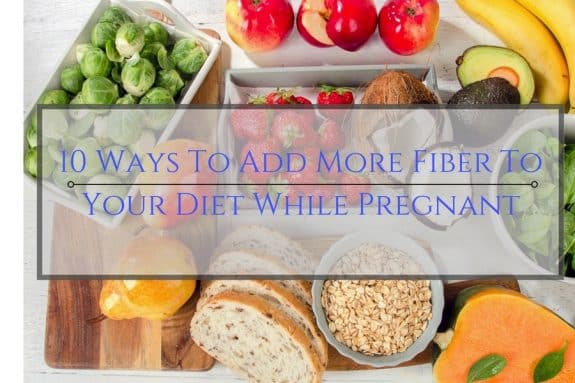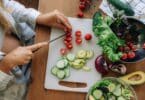Fiber is an essential part of every well-balanced diet. It can aid in bowel elimination and it is important for the regulation of blood sugar and energy levels. During pregnancy, it can also help to regulate blood pressure and may even reduce your risk of preeclampsia in your last trimester. Unfortunately, the average person only consumes about 14 grams of fiber per day, which is substantially lower than what is recommended. Expectant mothers, who actually need more fiber during pregnancy, should consume at least 25 grams of dietary fiber per day. Boost your intake with help from the following tips.
Try Drinking Your Fiber
If you’re just starting out with fiber, aren’t really a fan of fruits, veggies, or whole grain foods, and are wary of things like chia and flaxseed, maybe the best way to start is by drinking your fiber. Try smoothies with a good mix of vegetables and fruit, or give tomato juice a try. If all else fails, you can always grab an over-the-counter fiber drink mix to get started. Just know that it isn’t the tastiest thing out there and that you really would fare better at getting your fiber in if you made a few small steps each week (suggestions to follow).
Start Your Day with a High Fiber Breakfast
Breakfast truly is the most important meal of the day – and it may even play a critical role in the consumption of fiber. In fact, a study from the University of California study determined that cereal eaters, on average, consumed more fiber than non-cereal eaters. Still, you don’t have to eat cereal to get in your fiber. You can do oatmeal, which also contains fiber, or you can eat an apple and some yogurt topped with bran cereal.
Add More Beans and Lentils to Your Diet
Beans and lentils are great sources of both fiber and protein. They’re also digested easier than other protein sources. Lentils and split peas are at the top of the fiber content list, weighing in at 16.3 and 15.6 grams of fiber per cooked cup. However, you can also use black beans (15 grams) or lima beans (13.2 grams) in your favorite dishes.
Find Ways to Add Flaxseed and Chia Seeds to Your Diet
Flax and chia might not contain a lot of fiber (3.8 grams and 5.5 grams per serving, respectively), but you can easily add them into your diet on a pretty regular basis. Flaxseed can be added to readings for chicken or fish, or it can be added to smoothies, oatmeal, and yogurt. If you’re really ambitious, you can even add it to your own homemade muffins or bread. Just make sure you always use ground flaxseed. The body cannot digest it in its whole seed form. Chia seeds are just as easy to use, and they can be added to smoothies, tasty drinks, teas, and even soups, yogurt, and oatmeal.
Get Creative with Your Veggies
Nearly all vegetables contain at least some fiber, so make sure you get in your daily servings! Dip them in low-fat ranch or your own Greek Yogurt dip (super easy to make! Just add dill and lemon juice). Toss them on your favorite sandwich. Try them in burritos and on top of enchiladas. Or make your own pizza and pile on your favorite sliced veggies. If you’re really not a veggie fan, try blending them up and then toss them in your soup. Or you could trade out water or your beef/chicken stock with vegetable broth.
Fruits Contain Fiber, Too!
Veggies tend to get more credit for their fiber content than fruit, but both actually contain fiber. Fruit also happens to be an easier choice for those who are not quite friends with vegetables. To make the most of your fiber intake, choose the fruits with the greatest amounts. This includes raspberries, pears, apples, and blackberries. It’s also worth noting that dried fruits pair wonderfully with other high-fiber foods, such as oatmeal, cereal, granola, and whole-grain muffins.
Transition to Whole Grains
One of the easiest ways to add more fiber into your diet is to choose whole grains over their white counterparts. Of course, if you’re used to the texture of white breads and pastas, it can take a little getting used to at first. So maybe make it a goal to trade out one white item for its whole grain counterpart per week. It don’ts matter which one you start with – pick bread, pasta, pizza crust, cereal, or bagels, tortillas, or even muffins – and automatically start upping your fiber intake on foods you already eat everyday. You can also try out new, more exotic grains, barley or amaranth, to mix things up a bit. Just make sure you’re searching for the words “whole grain” on the ingredients list of anything you’re switching out.
Trick Yourself into Eating Bran
Not everyone can eat bran cereal straight out of the box, but even just 1/3 of a cup contains 8.5 grams of fiber. So, instead of trying to force an entire bowl of bran down your throat, why not try mixing just a bit of it into your favorite cereal? This will give you a little extra fiber without all the bland.
Switch Out Your Usual Sandwich Condiment and Use Hummus Instead
Hummus, which is made from chickpeas, is an excellent source of fiber. Just 1/2 cup contains 7.5 grams! (Add lettuce and tomato to that sandwich and you’ve upped your fiber intake just a tad bit more.) Hummus is also great as a dip for your veggies and in burritos. If you have to have a guilty snack – say, maybe pretzels – hummus works pretty well with those, too! Speaking of guilty snack foods . . .
Use Brown Rice or Oatmeal in Place of Breadcrumbs
Both great sources of fiber, oatmeal and brown rice can easily be used in place of bread crumbs. For example, use oatmeal or brown rice in place of bread crumbs in your favorite meatball recipe, or try sprinkling oatmeal on top of your favorite casserole or pie. You can also easily add oatmeal to breads, muffins, and cakes.







